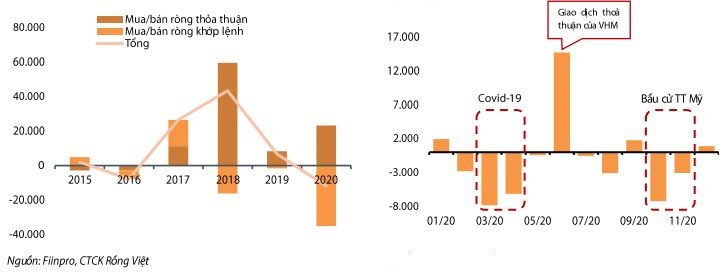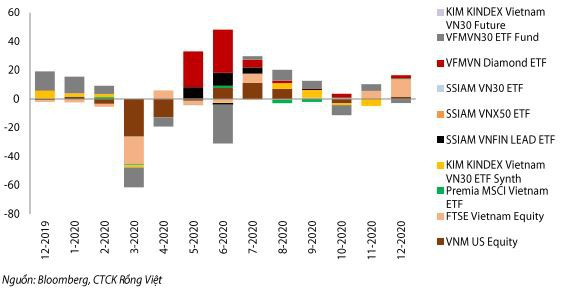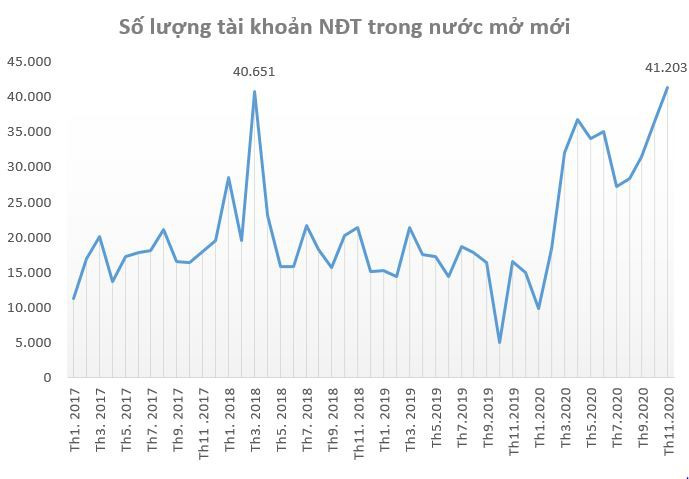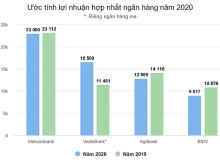The appearance of Covid-19 makes 2020 a special year for the stock market (stock market). VN-Index moved investors from a state of panic when a series of stocks plunged, evaporating most of their accounts, to excitement when “buy whatever you buy” when the market sublimates. Looking back over the past year, many investors are still hard to believe in what has happened to the stock market.
Movements of VN-Index from the beginning of 2020
Sorrowful Records have never been seen
The optimistic prospect for a prosperous 2020 of Vietnam’s stock market is soon covered by the shadow of the Covid-19 pandemic. The negative reaction of investors led to a row of strong sell-offs, causing the market to wobble. Within just 2 months since the domestic Covid-19 broke out, the VN-Index fell 33.51% to its lowest level in three years.
The plunge of the market in the first quarter brought with it a series of sad records such as the strongest drop in history (March 9 with a decrease of 6.28%). Even then, the VN-Index once more decreased by more than 6% in 1 session on March 23, thereby making March 2020 become the strongest dropping month in Vietnam’s stock history with a decrease of 24.9%. .
The time the market started to fall was also the source of a big sell-off wave that had never been seen in many recent years. In 2020, foreign investors have made a record net sale of nearly 15,000 billion dong on HoSE. Excluding the put-through transactions, this number could reach 38,000 billion VND, including many Bluechips such as MSN, HPG, VIC, HDB, VNM …
In which, foreign investors had 2 stubborn net selling chains on HoSE. The first chain was 33 consecutive net selling sessions that took place in February – March with a total value of more than 9,500 billion dong. The second longest net selling chain took place in October – November with 30 consecutive sessions, totaling VND 10,546 billion.

The complicated developments of world events like Covid-19 and the US presidential election have made foreign capital flows somewhat afraid of frontier markets like Vietnam when the general sentiment of foreign investors is Gradually withdraw capital to reduce risk during events of global scale and shift to safer assets such as bonds or stocks of developed countries.
In 2020, foreign investors maintained their position of net selling through matching channel but they net bought positively through agreement channel. The most prominent was the strong net buying of foreign investors in VHM shares in June 2020 with a value of VND 14,170 billion. This shows that foreign investors are starting to be more selective in their capital investment.
Different from the persistent net selling status of active foreign capital flows, the cash flow through ETFs has a little more positive signal. Although there was also a strong net withdrawal in some periods, especially in March and April, but this capital flow has returned to be quite stable in most of the rest of the year.
The year 2020 will also see a wave of internal ETFs with 4 new ETFs including 2 SSIAM (VNFINLead and SSIAM VN30), VFM (VFMVN Diamond) and VinaCapital (ETF VINACAPITAL VN100). Notably, VFMVN Diamond fund based on VN Diamond index, although only trading on HoSE since May 2020 with an initial scale of 102 billion dong, has rapidly increased its capital by 39 times as of the end. year.

In the past, the market often tended to have negative movements when foreign investors boosted net selling, but domestic cash flow with the predominance of margin leverage has reversed this trend recently.
“THE DEATH” HAVE NO FINISHED POINTS
The low-cost environment facilitates securities to attract cash flow from investors in the context of other traditional investment channels such as gold, real estate, savings, … less attractive. This is also the driving force that created one of the most exciting waves on the stock market ever.
In fact, the bottom-fishing force began to appear from the end of Q1, pushing the market liquidity gradually to improve, but the difference is only really clear since the second half of 2020, especially in the final months.
According to statistics, in the last 4 months of the year alone, the liquidity through the matching channel on HoSE reached more than 630,000 billion VND, approximately the value of the whole year of 2019. Investors are getting used to the value of transactions. regularly maintaining above / below 14,000 billion VND / session, something that has never happened even during the period when the VN-Index reached its historic peak in early 2018.
Liquidity constantly climbed and exploded in the last months of the year
The influx of money flowing into the market along with good domestic disease control is the main driving force to create a “unprecedented” reversal of Vietnam’s stock market.
From the bottom at the end of March, the VN-Index regained all the lost things from the beginning of the year in less than 5 months. Vietnam’s stock market even set a record for two consecutive months in September and October when having the strongest growth in the world.
Not stopping there, the cash flow smoothly rotating among Bluechips continued to bring the VN-Index to conquer the threshold of 1,000 points at the end of November and moreover at the end of the year over 1,100 points, recording an increase of nearly 15% compared to that of the begin of the year. This figure is much more impressive than the 7.67% increase in 2019 and is something that few investors dare to think about 8 months ago.
As a cycle, the rise of most Bluechips indirectly boosted market liquidity through margin leverage. According to statistics, the margin lending balance on the whole market as of the end of the third quarter of 2020 reached over 66,000 billion dong, up 19% from the previous quarter and 33% higher than the quarter 1/2020.
Liquidity continuously exploded and hot cash flow showed no signs of cooling down, making the “tsunami” on the stock market unknown when it will stop.
HIGHLIGHT “F0” MARK
The special rising wave of Vietnam’s stock market bears the imprint of a new “wave” of new investors “F0” with a somewhat bolder risky appetite than the classes of experienced investors. The attractive growth of stocks in recent years has attracted the attention of new classes of investors, thereby becoming the main driving force for the market to continue going up.
In fact, stocks started to get more attention after being listed by the Government on the list of essential goods permitted to operate during the period of social isolation in early April. Number of individual accounts in the country New openings in the country started to skyrocket and continued at over 30,000 units per month.
In November, the number of new domestic individual investors opened up to a record 41,080 accounts. Accumulated in 11 months, this number of new accounts opened reached 329,452 units, an increase of 75.4% compared to the whole year of 2019.

New cash flow of investors “F0” brought a new wind to the stock market, helping VN-Index regain all the lost things and even surpass the peak of 2019 and bring many stocks to establish. new peak.
Notably, stocks with small and medium capitalization often have the largest trading volume in the market due to their low market price and high speculation. However, between the end of November and the beginning of December, many Bluechips reached the top of stocks with the largest trading volume in recent years with several tens of million units per session.
The explosion of new open accounts is a positive signal showing that investors’ confidence in the stock market is improving day by day. However, there is an increasing pressure on the technology infrastructure to ensure the smooth operation of the transaction system.
Recently, HoSE’s trading system has been overloaded many times due to the continuous increase in cash flow into stocks and no signs of cooling down.
In order to reduce the pressure on the system, HoSE decided to officially implement the increase in the minimum trading lot from 10 to 100 shares starting from January 2021. Previously, HoSE opened a trading system for securities companies to connect and test from December 16 to December 22, 2020.
However, this measure can only partially relieve pressure on the system, but cannot completely solve the problem. In the context that market liquidity is forecast to continue to increase in the future, especially if the T + 0 mechanism is applied, HoSE and securities companies need to invest in better system upgrades to avoid problems. not worth it, causing loss of confidence in investors.
THANH HA
Source: bizlive.vn – Translated by fintel.vn
















